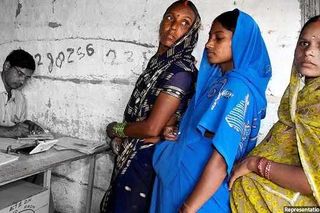
Odisha’s Maternity Benefits Are Touted as a Success; That’s Only Half the Story
The state has made strides in providing wage compensation and nutrition to pregnant women, but access to quality health care is still lacking.

On a humid summer afternoon, Phoola Bhumij sits outside her thatched hut with her in-laws and watches her child play in the shade. Her family and neighbors chat loudly while drying mahua flowers, washing and chopping vegetables, or just idling away time together. The child, now more than a year old, crawls on the ground and makes faces at his mother. Looking at them, there’s no way one could fathom the difficulties Bhumij andher family faced for a safe childbirth in a hospital.
“If I had not wished for an institutional delivery, I might have had it easier in life. But, who knows? Pregnancy is never easy anyway,” Bhumij says.
She is a young, frail adivasi woman living in Deulahuli, a village in the mountains of Banei block, Sundergarh district of Odisha. The easiest way to reach Deulahuli is by a 2.5 kilometer uphill road from its nearest village, Patrapalli, which itself is a 2-kilometer walk from the Govindpur Panchayat Bhawan. On reaching Deulahuli, however, it is not a difficult task to find Bhumij — the entire village remembers that time, over a year ago, when she walked down the hills for nearly an hour, in labor, just to reach the ambulance at the foothills.
The first time Bhumij experienced labor pain, it was mild, and walking down the hill to the ambulance was a manageable feat. When the doctors in Banei hospital ruled it out as a false alert, they found other pressing complications. Bhumij was anemic and needed two packets of blood. The family ran helter-skelter to arrange the blood on time and then waited by her side for two days until her discharge.
A week later, back at home, Bhumij began screaming in pain.
Her father-in-law ran down the hill and arranged for an ambulance to wait at the bottom. Her husband and mother-in-law on either side, Bhumij walked down the hill, again writhing in pain. “Those were the longest 45 minutes of my life. I know that my body wanted to give up every second, but I don’t know how they still managed to keep me going.”
Odisha is heralded as a success story in maternity entitlements. As the Jaccha Baccha Survey, 2019, confirms the beneficiary coverage for the state’s maternity program, Mamata Yojana, is about 90% better than that of the Pradhan Mantri Matru Vandana Yojana (PMMVY), the central government-sponsored maternity entitlement scheme. Similarly, Mamata Yojana remains way ahead of PMMVY in terms of the money being actually credited to these women. And the state’s efforts to ensure nutritional support for expecting women have been largely commendable, compared to the Centre’s scheme. The Odisha government now takes great pride in these findings and leaves no stone unturned in showcasing these celebrations. What remains obscured here is that this is not a complete realization of the maternity entitlements.
“Maternity entitlement is, in fact, composed of three factors: wage compensation, nutritional support, and access to affordable health care,” says Dipa Sinha, an economics professor at Ambedkar University, Delhi, and Right to Food activist.
In Odisha, women’s right to accessible and affordable health care is still neglected. Bhumij’s experience is not an isolated instance.
Related on The Swaddle:
AIIMS Fire Is Symbolic of India’s Flailing Public Health Care System
“The road [to Deulahuli] has been under construction for as long as I can remember. I can recall only two or three times that an ambulance service was of any use to the pregnant women of Deulahuli in the last couple of years,” says the anganwadi worker from Patrapalli.
Reports of inaccessible health care for pregnant women are not new in the state. In October 2019, a regional news channel reported instances of women from hilly parts of the Malkangiri district in the state walking 5 to 6 kilometers during labor to reach the Chitrakonda government hospital. These areas, too, remain primarily populated by adivasis. The hospital has three different ambulance services, but none work when women need it the most.
Without access to the hospital, most pregnant and lactating women in Deulahuli rely on the village dai (midwife). “She does whatever she can do best,” even Bhumij’s mother-in-law testifies. But a dai can only do so much. Interviews with women under the dai’s care reveal most suffered from vaginal bleeding, stomach cramps, and back pain for at least 10 days after the delivery, with only chera-muli (a traditional medicine of leaves and stems) to chew for relief.
A report published by the Comptroller and Auditor General (CAG) of India in 2017 notes the health check-up of pregnant women and nursing mothers in Odisha was “significantly low,” covering only half of pregnant women and nursing mothers. The report also confirms the hypothesis that the abysmal fate of health care services affects vulnerable groups the most. Adivasis have to cover anything between a distance of 5 to 80 kilometers to reach a district or community health center. The national average distance to a community health center stands at about 13.55 kilometers.
The implications of this lack of access show up in the findings of the National Family Health Survey 4 (NFHS-4): The infant mortality rate (IMR) in adivasi populations is 44.4%, about 30% higher than the rest of the population; the 2018 tribal ministry report says even these figures are underestimations.
Related on The Swaddle:
Inadequate Government Child Care Schemes Stall India’s Economic Progress
To respond to some of these challenges, in 2017, the Odisha government had announced a “Bike Ambulance Service” as an immediate solution for remote villages. Even years after that announcement, a quote by Sanjib Joshi in a Caravan report from 2016 still remains eerily true: “It’s not uncommon to see tribal people carrying patients or dead bodies of their relatives in sling here because most of the time it’s not about money but unavailability of ambulance and the inaccessibility of the terrain.”
The success of a maternity entitlement scheme cannot be gauged without taking all three factors into account. To forget any one or more of the three components of maternity entitlements is nothing short of irresponsibility and apathy of a state to ensure the rights of women.
Not acknowledging the failings of so-called success stories like Odisha’s maternal entitlement scheme allows inequities to continue. This blindness to flaws also perpetuates elite, top-down (mis)understandings of public health that blame disadvantaged women for their continued disadvantage – such as assumptions that home delivery is simply ‘adivasi culture.’ The experiences of the women in Deulahuli show otherwise – and show the state and the country where improvements are sorely needed. As one pregnant woman there comments, “Arrre, why would we adivasi women not want to feel safe and healthy in some clean and affordable hospital? But, do we have any such option available to us?”
Sweta Dash is a gender studies scholar at Ambedkar University Delhi. She is currently researching maternal health in India, primarily focusing on the implementation of Mamata Yojana, Odisha's state-sponsored maternity entitlement. She is associated with the Right To Food campaign and the Rethink Aadhaar collective.
Related


The Health Condition That Causes Unexpected, Unwanted Sexual Arousal
